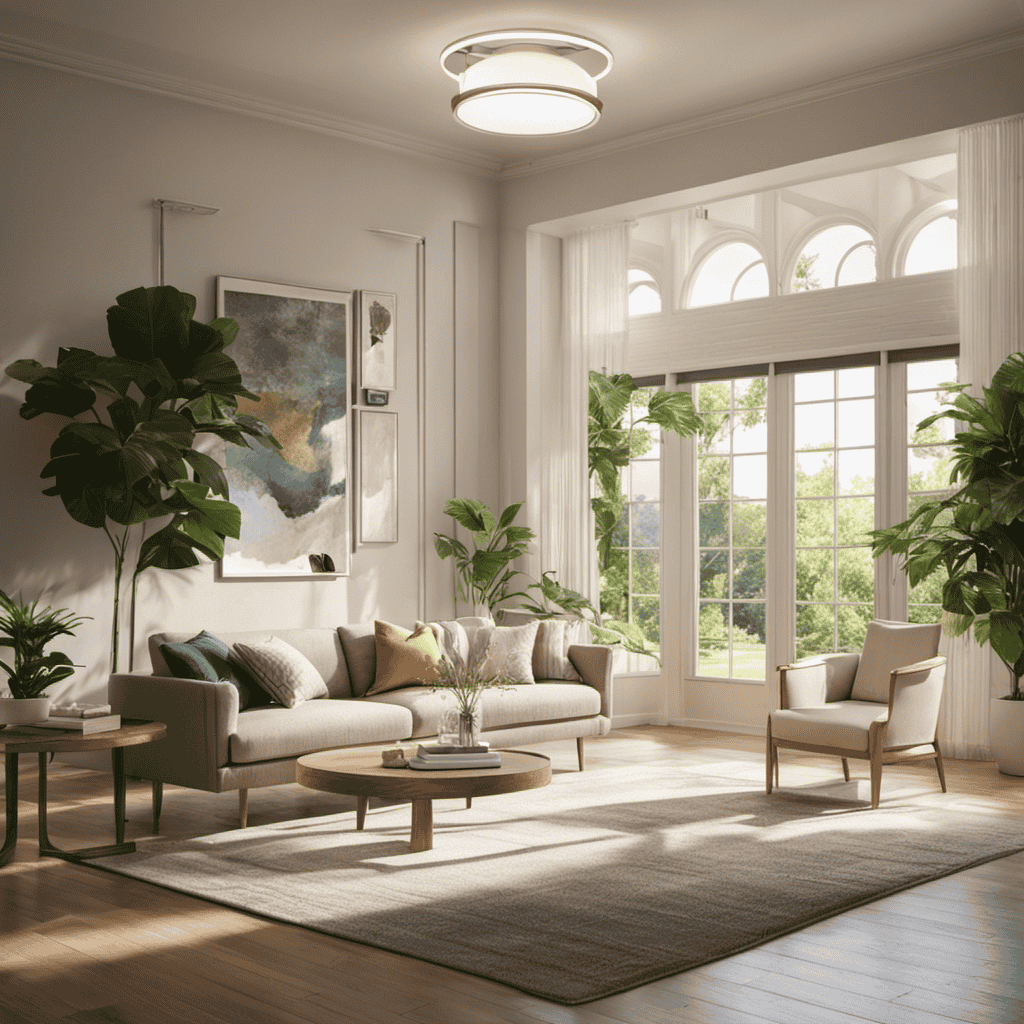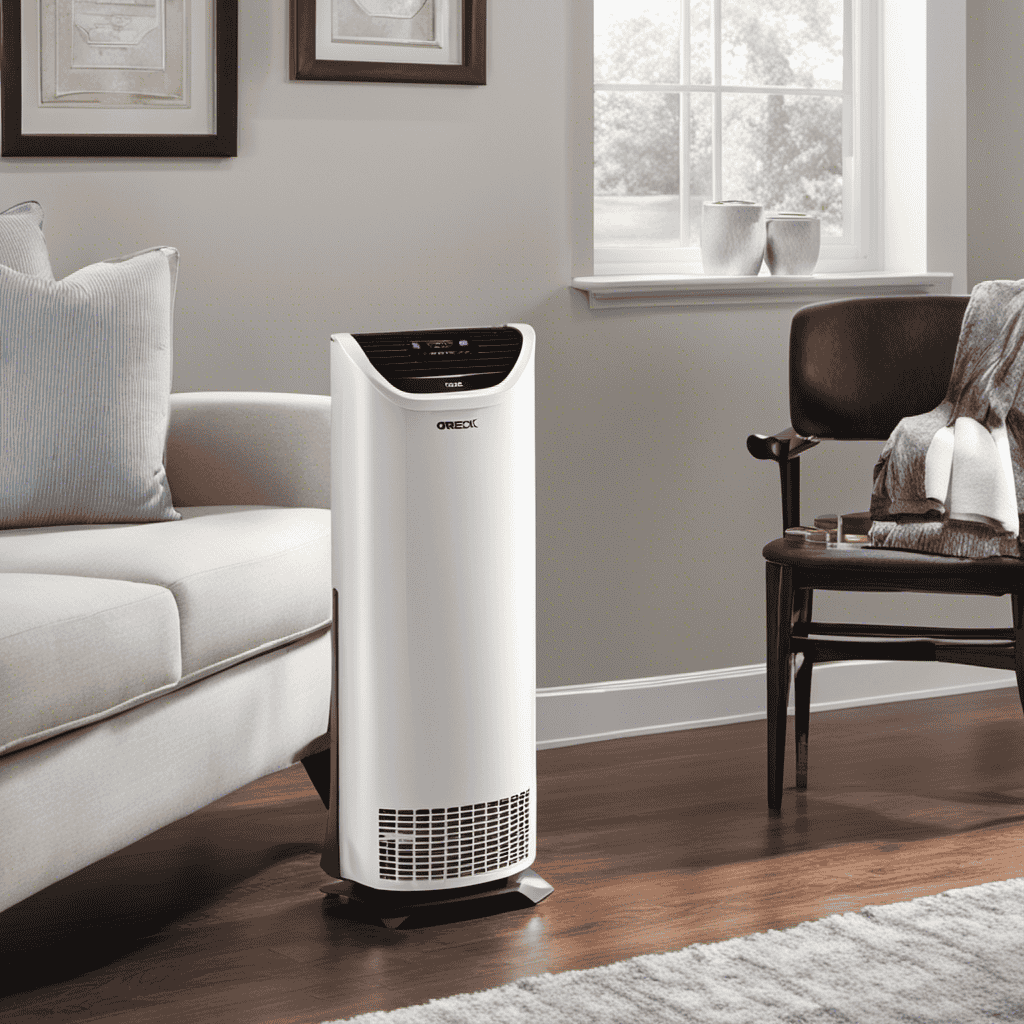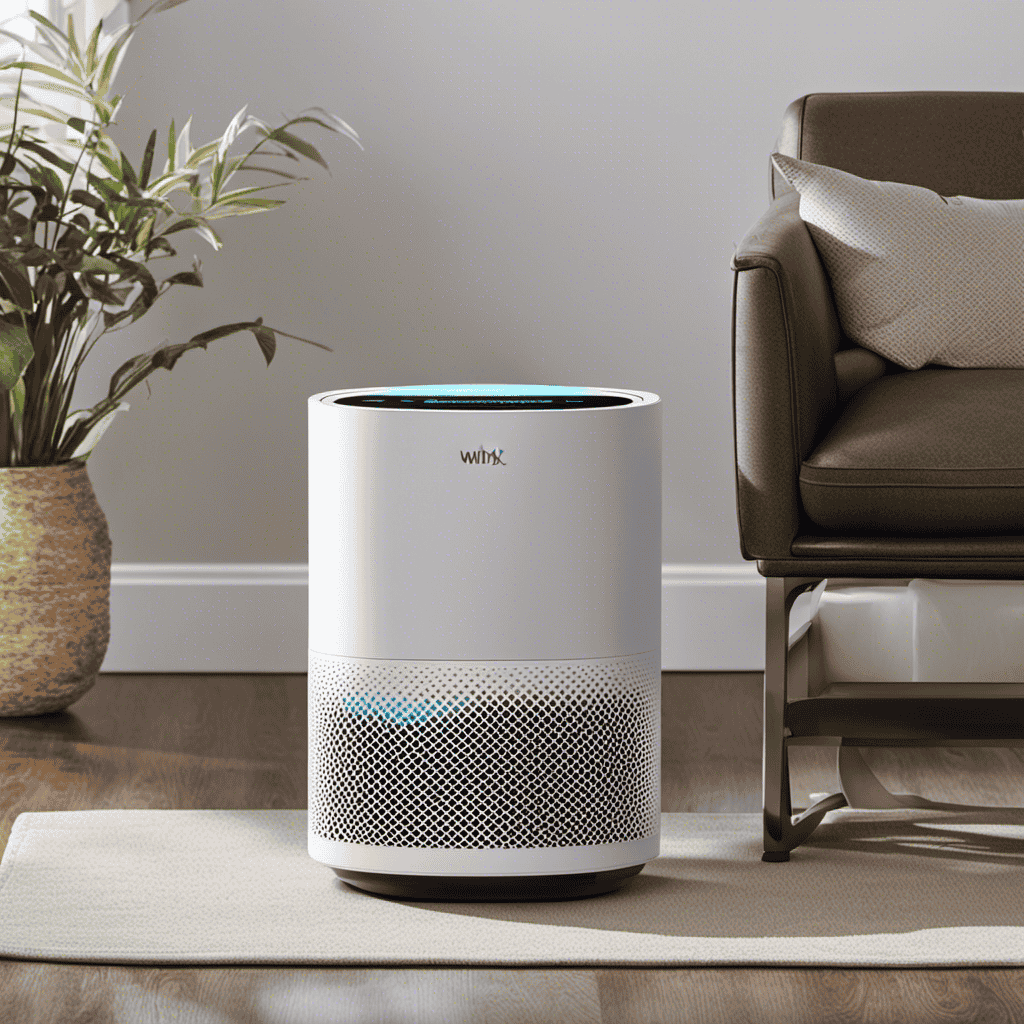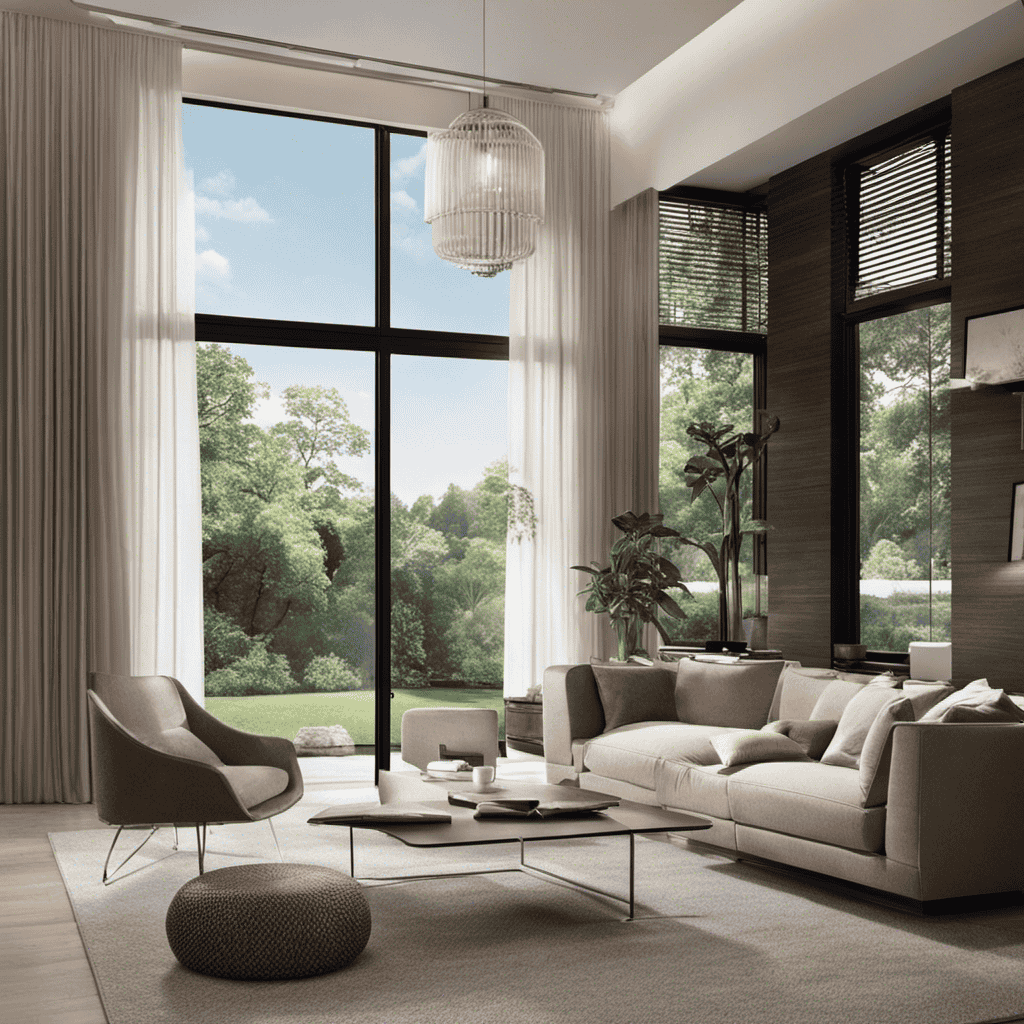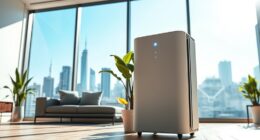I find it ironic that we all desire clean air, yet often overlook the amount of time it takes for an air purifier to fully clean a room.
In this article, I’ll delve into the factors that affect an air purifier’s cleaning time, including room size, CADR, and filter efficiency.
I’ll also provide tips on optimizing performance and realistic expectations for cleaning time.
So, let’s dive in and uncover the truth about air purifier efficiency.
Key Takeaways
- Factors such as room size, air pollution level, air purifier type, and room layout all affect the time it takes for an air purifier to clean a whole room.
- The recommended cleaning time for different room sizes varies, with larger rooms requiring more time to clean thoroughly. Air purifier efficiency and air quality also impact cleaning time.
- CADR (Clean Air Delivery Rate) is a measure of an air purifier’s ability to remove pollutants, but it does not consider different pollution levels. CADR should be evaluated alongside air quality to determine efficient cleaning.
- Air changes per hour (ACH) determine how quickly air is refreshed and higher ACH leads to cleaner air. Filter type and efficiency also play a role in cleaning time, with higher quality filters capturing more particles and impacting cleaning duration.
Factors That Affect Air Purifier Cleaning Time
There are several factors that can affect how long it takes an air purifier to clean the whole room.
The effectiveness of an air purifier can be influenced by various factors, such as the size of the room, the level of air pollution, and the type of air purifier being used.
The size of the room is an important factor because larger rooms will require more time for the air purifier to circulate and clean the air effectively.
Additionally, the level of air pollution in the room can impact the cleaning time. If the air is heavily polluted, the air purifier may need more time to filter out the contaminants.
Moreover, the layout of the room can also influence the cleaning time. If the air purifier is obstructed by furniture or walls, it may take longer to clean the entire room.
Therefore, it is essential to consider these factors when determining the cleaning time for an air purifier.
Recommended Cleaning Time for Different Room Sizes
The recommended cleaning time for different room sizes varies. To determine the appropriate cleaning time for your room, consider the size of the space and the efficiency of your air purifier.
Here are a few key factors to keep in mind:
-
Room size: Larger rooms generally require more time to clean thoroughly. It is recommended to run the air purifier for longer periods in larger rooms to ensure optimal air quality.
-
Air purifier efficiency: The efficiency of your air purifier plays a significant role in determining the cleaning time. Higher efficiency models can clean the air more quickly and effectively.
-
Air quality: If the air in your room is heavily polluted, it may take longer for the air purifier to clean it. In such cases, it is advisable to run the air purifier for extended periods to achieve desired results.
-
Filter condition: Regularly cleaning or replacing the filters in your air purifier can enhance its efficiency and reduce the cleaning time.
Keeping these factors in mind will help you determine the recommended cleaning time for your specific room size and air purifier efficiency.
Understanding Air Purifier CADR (Clean Air Delivery Rate
To understand the CADR of your air purifier, you should consider its efficiency in delivering clean air.
CADR, or Clean Air Delivery Rate, is a measure of an air purifier’s ability to remove specific pollutants from the air within a specific time frame.
However, it is important to understand the limitations of CADR. While it provides a standardized way to compare air purifiers, it does not take into account the impact of different air pollution levels on the cleaning time.
Higher levels of pollutants in the air will require more time for the air purifier to effectively clean the room.
Therefore, it is crucial to consider the CADR in conjunction with the air quality in your specific environment to ensure that your air purifier is able to efficiently clean the room in a timely manner.
How to Calculate Air Changes per Hour (ACH) for Effective Cleaning
Calculating ACH is essential for determining how quickly the air in a room is refreshed by an air purifier. ACH is calculated by dividing the volume of air in the room by the flow rate of the air purifier. This measurement is crucial in evaluating the efficiency of an air purifier and ensuring proper maintenance.
Here are some key points to consider when calculating air purifier efficiency:
- A higher ACH indicates that the air in the room is being refreshed more frequently, leading to cleaner air.
- Proper maintenance, such as regularly cleaning or replacing filters, is essential for maintaining optimal ACH.
- Regularly monitoring ACH can help determine if the air purifier is operating at peak efficiency or if adjustments need to be made.
- Calculating ACH can also assist in determining the appropriate size and placement of air purifiers for different room sizes and air quality needs.
Understanding how to calculate ACH and the importance of proper maintenance sets the foundation for exploring the role of filter type and efficiency in cleaning time.
The Role of Filter Type and Efficiency in Cleaning Time
When it comes to air purifiers, the quality of the filter plays a crucial role in determining the cleaning time. Higher quality filters are designed to efficiently capture and remove a larger number of airborne particles, reducing the overall cleaning time.
Additionally, the efficiency of the filter also impacts the duration of the cleaning process, as filters with higher efficiency are more effective in trapping pollutants and can clean the air more quickly.
Therefore, understanding the filter quality and efficiency is essential in optimizing the cleaning time of an air purifier.
Filter Quality and Time
You’ll want to consider the filter quality and how long it takes to clean the whole room when choosing an air purifier. The filter quality is crucial in determining its effectiveness in removing pollutants from the air. A high-quality filter will be more efficient in trapping particles, allergens, and odors.
Additionally, the filter maintenance is an important factor to consider. Some filters may require frequent cleaning or replacement, which can add to the overall cost and maintenance of the purifier.
Another aspect to consider is the noise level. Some air purifiers can be quite noisy, especially on higher fan speeds, which can be disruptive in a quiet environment.
To summarize, when choosing an air purifier, prioritize filter quality, consider filter maintenance requirements, and take into account the noise level for a comfortable and efficient experience.
Efficiency Impact on Duration
The efficiency of the air purifier directly affects how quickly it can remove pollutants from the environment. There are several factors that can affect the efficiency of an air purifier, including the quality of the filters, the size of the room, and the layout of the room.
The quality of the filters is crucial because it determines how well the air purifier can capture and trap pollutants. Filters with a higher MERV rating are more effective at removing smaller particles, such as dust and pollen.
Additionally, the size of the room plays a role in the cleaning duration. A larger room will require a more powerful air purifier or a longer cleaning time.
Furthermore, the layout of the room can impact the efficiency of the air purifier. If there are obstacles in the room, such as furniture or curtains, it may hinder the airflow and reduce the effectiveness of the air purifier.
Therefore, it is important to consider these factors when determining how long it will take an air purifier to clean the whole room.
Additional Features That Impact Air Purifier Cleaning Speed
One important factor that affects how long it takes your air purifier to clean the whole room is the presence of additional features. These features can greatly impact the cleaning speed and efficiency of your air purifier.
Here are some additional features to consider:
-
Adjustable Fan Speed: Some air purifiers offer multiple fan speed settings, allowing you to increase the cleaning power when needed or reduce it for quieter operation.
-
Timer Function: This feature allows you to set a specific duration for the air purifier to run. It can help optimize cleaning time and energy usage.
-
Auto Mode: Air purifiers with auto mode can detect the air quality in the room and adjust the fan speed accordingly. This ensures that the air purifier operates at the most efficient level based on the current air quality.
-
Filter Replacement Indicator: This feature alerts you when it’s time to replace the filters, ensuring that your air purifier continues to clean the air effectively.
Considering these additional features when choosing an air purifier can help you optimize its cleaning speed and performance.
Now, let’s explore some tips for further enhancing air purifier efficiency and reducing cleaning time.
Tips for Optimizing Air Purifier Performance and Cleaning Time
Considering these features can help optimize the performance and speed of your air purifier.
To improve air quality and maximize cleaning time, regular maintenance is essential. Firstly, make sure to clean or replace the filters as recommended by the manufacturer. Clogged filters can hinder airflow and reduce efficiency.
Additionally, keep the surrounding area clean and free from dust and debris. This prevents the air purifier from working harder than necessary. Regularly vacuuming and dusting the room can significantly improve the effectiveness of the purifier.
Lastly, consider the size and capacity of your air purifier. A larger unit with a higher CADR (Clean Air Delivery Rate) will be able to clean the room more efficiently.
By following these maintenance tips and considering the features of your air purifier, you can optimize its performance and speed, ultimately improving air quality in your home.
Now, let’s discuss realistic expectations: how long it actually takes to clean a whole room.
Realistic Expectations: How Long It Actually Takes to Clean a Whole Room
When it comes to achieving complete purification in a room, there are a few key factors to consider.
Firstly, the time it takes for an air purifier to fully clean a room depends on its size and the Clean Air Delivery Rate (CADR) of the purifier. A larger room will require a longer purification time, while a higher CADR will result in faster and more efficient cleaning.
Secondly, room size considerations also play a crucial role in determining the effectiveness of an air purifier. A purifier designed for smaller rooms may struggle to effectively clean a larger space, leading to subpar air quality. It is important to choose an air purifier that is suitable for the size of the room to ensure optimal purification results.
Time for Complete Purification
To get the whole room purified, it’ll take your air purifier some time. The efficiency of an air purifier is influenced by various factors.
One of the key factors is the size of the room. Larger rooms will require more time for complete purification as there is more air to filter.
Another factor is the air purifier’s Clean Air Delivery Rate (CADR), which determines how quickly it can clean the air.
Additionally, the presence of pollutants such as dust, allergens, or smoke can also impact the efficiency of the purification process.
Lastly, the layout of the room plays a crucial role. If the room has multiple partitions or obstacles, it may hinder the airflow and reduce the effectiveness of the air purifier.
Therefore, it is important to consider these factors when determining the time it takes for your air purifier to clean the entire room.
Room Size Considerations
The size of your room will affect how quickly your air purifier can purify the air. To determine the appropriate air purifier for your room, you need to consider the room size measurement. This measurement is typically calculated by multiplying the length and width of the room.
Once you have the room size, you can select an air purifier with the appropriate Clean Air Delivery Rate (CADR) to effectively clean the air in your space. Additionally, the impact of air pollution levels in your area should also be taken into account. If you live in an area with high pollution levels, you may need a more powerful air purifier or multiple units to effectively clean the air in your room.
It’s important to choose the right size air purifier to ensure efficient and thorough purification.
Frequently Asked Questions
Can an Air Purifier Clean the Whole Room Instantly?
An air purifier is effective in cleaning the whole room, but it doesn’t work instantly. However, the benefits of using air purifiers include removing airborne pollutants, improving air quality, and reducing allergy symptoms.
Do Air Purifiers Remove All Types of Pollutants From the Air?
Air purifiers are effective at removing various types of air pollutants, such as dust, pollen, pet dander, and smoke. However, they may not eliminate all pollutants instantly, as it depends on factors like room size and purifier capacity.
Can an Air Purifier Eliminate Odors From the Room?
Yes, an air purifier can eliminate odors from the room. It effectively removes airborne particles, including odorous molecules, improving indoor air quality. Using an air purifier has many benefits, including reducing allergies and respiratory issues.
Should I Keep My Windows Open While Running an Air Purifier?
When running an air purifier in my bedroom, I wondered if it was necessary to keep the windows open. I also wanted to know if air purifiers could help with my allergies.
How Often Should I Change the Filters in My Air Purifier?
I change the filters in my air purifier every 3-6 months. It’s important to clean the vents regularly to maintain optimal performance. The benefits of using an air purifier in a home include improved air quality and reduced allergens.
Conclusion
In conclusion, the time it takes for an air purifier to clean an entire room depends on several factors. These factors include room size, CADR, ACH, filter type, and additional features. By understanding these factors and optimizing the performance of your air purifier, you can achieve effective cleaning in a reasonable amount of time.
However, it’s important to have realistic expectations and not expect instant results. Remember, patience is key when it comes to achieving clean and fresh air in your living space.
So sit back, relax, and let your air purifier do its job. Gradually, it will transform your room into a haven of pure air.

